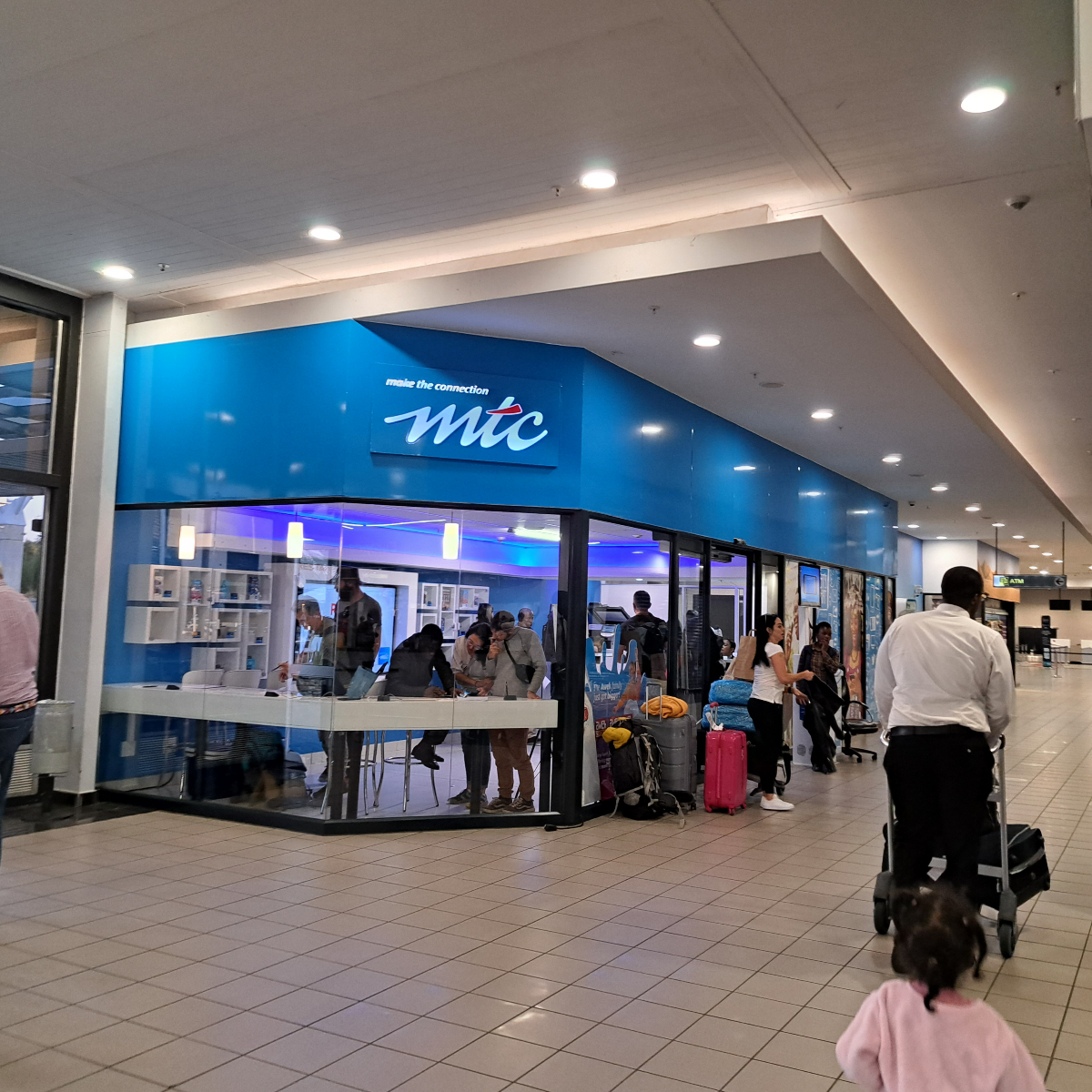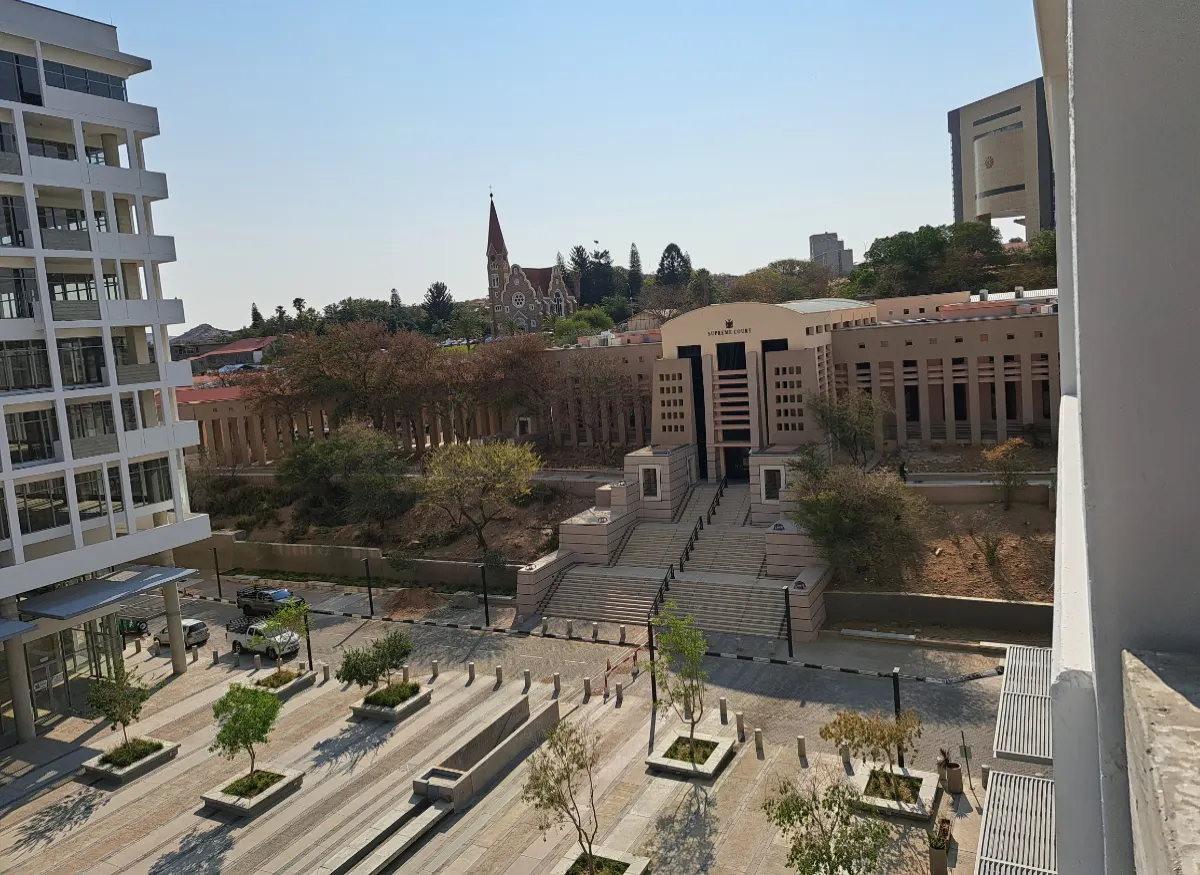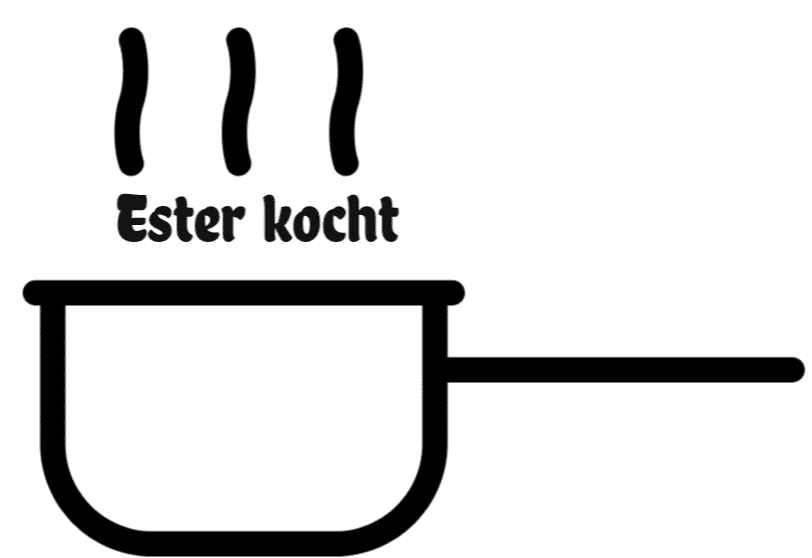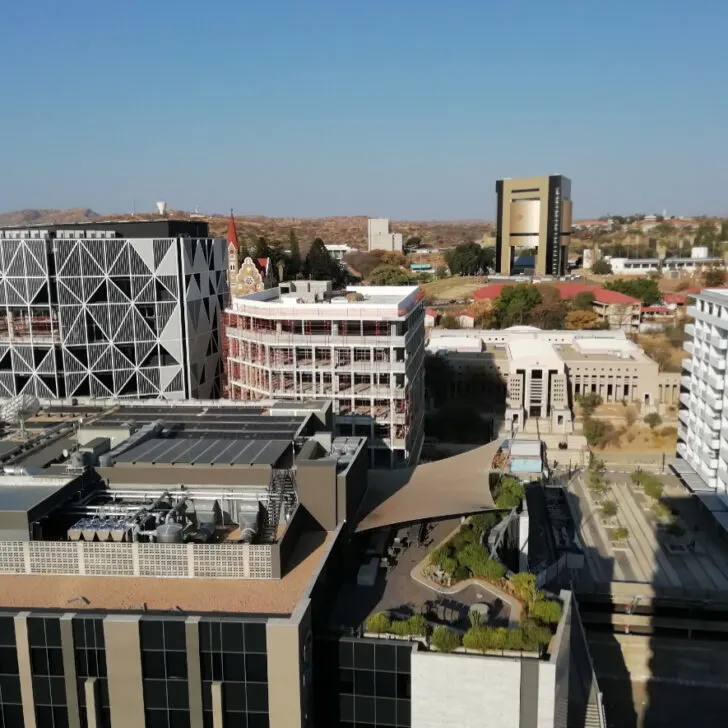Windhoek, Namibia’s vibrant capital, offers a unique blend of modern city life, rich history, and diverse cultural influences. Nestled in the central highlands and surrounded by scenic mountains, Windhoek is often the first stop for travelers exploring Namibia.
While it may not be known as a typical tourist destination, the city has plenty to offer—from historical landmarks and bustling markets to lively restaurants and a growing café culture. Plus, Windhoek is the perfect place to experience Namibian cuisine, whether at street stalls, local eateries, or fine dining establishments.

Here’s my ultimate Windhoek travel guide, covering everything from practical travel tips and must-see attractions to where to eat and what to do—so you can make the most of your time in Namibia’s capital!
- Best Time to Visit Namibia
- Car Rental & Safety Tips
- Why Windhoek?
- Before You Arrive: Download an Offline Map
- Money Exchange & Currency
- Getting a Local SIM Card & Internet
- Getting Around Windhoek
- Where to Stay in Windhoek
- Where to eat in windhoek
- What to Do in Windhoek
- Electricity and Power Plugs in Namibia
- Final Thoughts
Best Time to Visit Namibia
Namibia has a dry, arid climate with plenty of sunshine year-round. Many assume Namibia only has summer, but in reality, it experiences all four seasons—sometimes all in one day! Mornings and evenings can feel like winter, while midday temperatures may shift between spring, summer, and autumn. So, pack accordingly!
Climate & Travel Seasons
- Summer (November–March): Extremely hot, especially in the desert, with temperatures often exceeding 35°C (95°F). Occasional rains turn the landscape green, but wildlife is more dispersed, and some gravel roads can be difficult to navigate.
- Winter (May–August): Pleasant daytime temperatures (20–25°C / 68–77°F) but cold nights, sometimes dropping below freezing—especially in the desert and high-altitude areas.
- High Season (July–October): The busiest travel period when wildlife viewing is at its best, as animals gather around water sources. Book accommodations well in advance!
- Shoulder Season (April–June, most of November): Fewer tourists, meaning better availability and even discounts at some accommodations.
- Low Season (December–March): Fewer crowds and lower prices, but the heat and occasional rains may affect travel plans.
Our favorite time to visit Namibia used to be May to June, as the weather was pleasant, there were fewer tourists, and we could often find better accommodation deals. However, because of our jobs and our kids’ school schedule, we are now forced to travel during the high season. Thankfully, Namibia is such a vast country that even during peak season, it doesn’t feel overcrowded—except when it comes to prices!
Car Rental & Safety Tips
If you plan to explore beyond Windhoek, renting a car is a great option. We always book a double cab 4×4 for our road trips across Namibia. Last time, we paid 42,000 NAD (~€2,166 / ~$2,282) for 32 days, which was a great deal.

We compare prices online with local providers and book before arriving in Namibia. Some car rentals in Windhoek offer airport pickup and drop-off services.
Important Safety Rule
In Namibia, we drive on the left. Very important: Never leave bags or valuables visible in your car! Even if the bag is empty, everything must be out of sight.
I always tell people who ask me for Namibia travel tips: Never leave bags in the car—or at least cover them so no one can see them.
After all, as the German saying goes, “Möglichkeit macht Diebe” (Opportunity makes thieves).
Unfortunately, my parents-in-law learned this the hard way. On their second visit to Namibia, during their last night before returning to Germany, they left a bag with souvenirs and handwoven baskets visible in their car. Although the apartment had a security guard, the bag was visible from outside, and someone broke into the car overnight and stole it.
This could have been easily avoided. Like in any major city, take care of your belongings, and everything will be fine!
Why Windhoek?
I thought I’d start with Windhoek, even though, for me, it never really felt like a typical “Namibia travel destination.” I lived there for years while studying at the University of Namibia, and whenever we visit Namibia, we usually spend only a few days in Windhoek. However, for many travelers, Windhoek is the first stop after landing at Hosea Kutako International Airport, located about 30 km outside the city.



Situated in a basin in the central highlands and surrounded by mountains, Windhoek—meaning “windy corner” in Afrikaans (a language of Dutch origin)—is known as one of the cleanest cities in Africa. As the capital, it is home to approximately 15.7% of Namibia’s population, which totals around 2.96 million people.
During the early 20th century, Namibia was under German colonial rule, and remnants of this influence can still be seen today. In Windhoek, for instance, landmarks like Christuskirche, built during that era, still stand, and some streets retain German names.
German influence is also evident in education, with German schools still operating today, and in Namibian cuisine, where sausages like Jagdwurst continue to carry their German names. However, today, less than 1% of Namibia’s population speaks German as their primary language.
Following German rule, Namibia came under South African administration, during which Afrikaans became the official language. When Namibia gained independence in 1990, English was declared the official language. However, in addition to English, indigenous languages such as Oshiwambo, Otjiherero, Rukwangali, Silozi, and Khoekhoegowab remain widely spoken.

Breathtaking view of Windhoek from Avani Hotel, featuring the city’s skyline, Christuskirche, and the iconic Independence Memorial Museum.
Due to repeated requests for a Windhoek travel guide, I decided to create this easy-to-follow guide packed with practical tips and useful insights about the city.
This is just the beginning of our Namibia travel guide, and we’ll continue updating it. We hope you enjoy exploring Windhoek!
Before You Arrive: Download an Offline Map
Before traveling to Namibia, it’s important to download an offline map of the country. It’s free, incredibly useful, and practical. Many rental cars don’t have built-in navigation systems, and renting a GPS device often comes at an extra cost. With an offline map, you can easily navigate Windhoek, whether on foot or by car.
Money Exchange & Currency
Upon arrival at the airport, you’ll find multiple currency exchange options to get Namibian dollars (NAD, symbol: N$). South African rand (ZAR) is also accepted in Namibia, but other foreign currencies, including US dollars and euros, are not accepted for payments.


In Windhoek’s city center, you’ll find additional money exchange offices. However, I wouldn’t recommend carrying large amounts of cash. It’s best to have just enough for accommodation (if it’s not prepaid and only accepts cash), local shops, and street vendors. Credit and debit cards are widely accepted in Windhoek.
Getting a Local SIM Card & Internet
At the airport, you’ll find MTC, Namibia’s largest mobile provider. A SIM card costs as little as 10 NAD (~€0.50 / ~$0.55) (you’ll need to fill out a form and present your passport). You can also purchase prepaid credit for mobile data.

How It Works:
- Purchase prepaid credit and choose from different data bundle options, typically valid for 7 days.
- These bundles often include some local call minutes, WhatsApp and Instagram data, and general internet usage.
- I recommend selecting an option with fewer call minutes and more data.
The MTC staff at the airport are very helpful. There are often long queues, but this location is the best for tourists—especially first-time visitors.
💡 Note: Free WiFi is rare in Namibia. Some accommodations offer it, but in many cases, you’ll need to pay for access—especially outside Windhoek. Internet speeds can also be slow, so getting a SIM card is highly recommended.
You can later top up your MTC credit almost anywhere—from gas stations and supermarkets to online platforms.
Getting Around Windhoek
Taxis & Public Transport
From the airport to Windhoek, you’ll find various transfer services and taxis. Airport taxis generally have fixed rates, payable in cash, and no prior booking is required. If you’re like my husband, who enjoys bargaining, you can try negotiating the fare.
- Taxi prices from the airport:
- From 250 NAD (~€12.50 / ~$13.75) per person
- 400–500 NAD (~€20–25 / ~$22–27.50) for a full taxi
Within Windhoek, taxis are the main form of public transport and are very affordable at 13 NAD (~€0.65 / ~$0.70) per person per ride. Taxis are easily identified by the unique identification numbers on their doors and rear windscreens.


Passengers often share rides, as taxis only depart when full. If you want a taxi to drop you directly at your accommodation in a different suburb, you’ll have to pay double. However, if you ask to be dropped off at a nearby taxi rank (usually at gas stations, supermarkets, or parking lots), you only pay 13 NAD.
If you see a taxi in the city center and need a ride—for example, to Grove Mall—you can simply use the hand signal or call out, “Taxi, Grove Mall!” That’s how we locals do it.
At the end of the month, however, getting a taxi can be more challenging. Unlike on regular days when taxi drivers actively look for passengers, at month-end, it’s the other way around—people are chasing taxis. Since many have just been paid, the city center is crowded with shoppers, and taxi ranks are packed.
As a tourist, I’d recommend avoiding banks, supermarkets, and fast-food places during this time, as long queues are common. Instead, head to a café or restaurant to grab something to eat. This applies not only to Windhoek but to the whole of Namibia—most people are tight on cash during the month, and once they get paid, they go out and spend.
At night, taxis become less available, and some refuse to drive to certain areas. As a tourist, I wouldn’t recommend taking taxis late at night. If you’re going out for dinner or drinks, it’s safer and more convenient to drive yourself.
Where to Stay in Windhoek
There is a wide range of accommodations both between the airport and Windhoek, as well as within the city itself, to suit any budget—ranging from hotels and guesthouses to apartments and even camping sites like Urban Camp.

Stunning Apartment View Overlooking the Supreme Court
Last summer, our flight was delayed, and we landed just before midnight. Since we were traveling with kids, we opted to stay between the airport and Windhoek rather than drive at night. I wouldn’t recommend driving at night in Namibia—especially for first-time visitors—due to the risk of wild animals on the roads.
In Windhoek, we used to stay in hotels like Avani when we had one or two kids, as they offer family rooms. Avani is located in the heart of the city and features wonderful views from the rooftop restaurant and bar, a rooftop swimming pool, luxury rooms, a gym, and a casino, as well as restaurants on the ground floor.

However, now as a family of five, we prefer booking apartments in the city center. Apartments provide more space for the kids and are more cost-effective, as most hotels only allow two adults and two children per room, forcing us to book two rooms.

Staying in the city center is convenient, with supermarkets, restaurants, and cafés all within walking distance. We only take taxis or drive when visiting different suburbs, such as Katutura, Klein Windhoek, Eros, Pioneerspark, Khomasdal, and Hochland Park.
For apartment bookings, we often use Airbnb or Booking.com. For hotels and guesthouses, we book directly on their websites. For families, I highly recommend booking accommodation in advance.
No matter where you stay in Windhoek—whether a hotel or an apartment—you’ll have a great time in the city!
Where to eat in windhoek
I have to warn you—most places are not very vegetarian-friendly, or at least the vegetarian choices are limited (though I’ve noticed this is slowly but surely changing). But for meat lovers, it’s a paradise!
Budget-Friendly & Local Fast Food Options
There are lots of cafés and fast-food places, like Hungry Lion, Wimpy, KFC, or Spur, all prepared with a local touch and found all over Windhoek.

Even in supermarkets, you can get freshly cooked Namibian classics, from beef stew and wors stew to grilled chicken, vetkoek with mince, potato salad, coleslaw, and a variety of pies—like chicken liver pie or steak pie.




If you have a sweet tooth, try the local favorites: cakes, koeksisters (syrup-soaked doughnuts), and fat cakes. These are great budget-friendly options for breakfast, lunch, or dinner.

Popular Restaurants & Dining Experiences
If you’re looking for high-quality Namibian meat, there are restaurants serving some of the best beef and game meat (including zebra steaks).
We always recommend friends to visit Joe’s Beerhouse—known for its fantastic Namibian meat dishes and unique atmosphere. It’s very important to book in advance by calling, emailing, or booking directly through their website, especially for larger groups, as tables are often fully booked.

For international cuisine, there are also places offering fine dining, fusion dishes, and great wine, such as Stellenbosch Wine Bar & Bistro. Stellenbosch is a fantastic spot for those who appreciate a good meal paired with excellent wine. Located in the heart of Windhoek, this bistro offers a blend of international and local flavors in a cozy, welcoming setting.
If you want to enjoy your meal with stunning views of Windhoek, there are also restaurants with panoramic city views, such as Windhoek Sky Restaurant, where you can dine while overlooking the cityscape.

Authentic Namibian Eating Experience
For an authentic local food experience, head over to Xwama Restaurant in Katutura, where you can try traditional Namibian dishes rarely found outside the country. From Oshingali and Oshifima to flavorful marathon chicken, Xwama offers a true taste of Namibia’s diverse food culture. The rustic décor and welcoming atmosphere make it the perfect spot to enjoy a hearty meal while soaking in the local vibe.
If you want to experience Windhoek like a local, visit Oshetu Market in Katutura and try Kapana—grilled beef strips cooked over an open fire and seasoned with Namibian BBQ spice. Stand side by side with locals and indulge in this flavorful street food, either eaten directly from the grill or wrapped in old newspapers for takeaway.

No matter your food preferences, Windhoek has something to offer for every traveler!
What to Do in Windhoek
Windhoek has so much to offer, and there’s plenty to do! Whether you’re a history buff, a foodie, or just love exploring new places, here are some recommendations we always give to travelers visiting Namibia:
1. Visit the Museums

Breathtaking view of Windhoek from Avani Hotel, featuring the city’s skyline, Christuskirche, and the iconic Independence Memorial Museum.
Museums are a must when visiting any big city, and Windhoek is no exception!
- The National Museum of Namibia (Independence Memorial Museum), located at 59 Robert Mugabe Avenue, is open Monday to Saturday (Monday–Friday: 09:00–16:30, Saturday: 10:00–15:00).
- Housed in an iconic building designed and built by a North Korean company, the museum showcases a rich collection of historical exhibits about Namibia and its neighboring countries.
- Situated in a prominent location, it also features a rooftop restaurant offering stunning city views.
- Entry is free, and exhibits are spread across four floors. You can explore at your own pace or hire a guide.
- Tip: Read up on Namibian history before visiting, as some key details are missing from the exhibits.
2. Christuskirche
This small but iconic church is one of the oldest public buildings in Windhoek, built in the early 20th century during German colonial rule. A visit to Windhoek wouldn’t be complete without seeing it!
Note: The church is only open on Sundays, so plan accordingly.

Stunning Apartment View Overlooking the Supreme Court and Christuskirche
3. Take a Katutura Tour
Katutura is a part of Windhoek that most tourists never see, but it’s a great way to experience the real Namibia.

Humble corrugated iron houses paint a vivid picture of life on the outskirts of Windhoek, where simplicity meets resilience.
This township was established in the 1950s during apartheid, when the Black population of Windhoek was forcibly relocated here. Today, it’s a vibrant and lively area full of markets, street food stalls, and shebeens (local bars).
A guided tour of Katutura will take you through:
- Open-air markets selling fresh produce and street food
- Shebeens, where you can enjoy local drinks
- A chance to try kapana, one of Namibia’s most-loved national dishes

4. Indulge in Kapana and Bring the Flavor Home
Even if you don’t take a full Katutura tour, you must try kapana! Simply hop in a taxi and ask the driver to drop you off at Oshetu Market, one of the best spots to enjoy this grilled meat experience.
You’ll find metal grills lined up, smoke rising, and locals gathered around, dipping freshly grilled beef strips into a kapana spice mix, salt, or bale.

If you enjoyed the kapana, grab some kapana spice to make your own at home. You can find it almost everywhere—sold in small plastic bags on the streets, in silver packages at supermarkets, or at food markets like Oshetu Market.
However, be cautious when buying, as some spice mixes contain flavor enhancers. It’s always a good idea to check the ingredients. I personally prefer buying kapana spice from Superspar (also called spar) supermarket, where you can find 100% pure spices, free from artificial colorings or additives, made by locals.
5. Join a Cooking Class in Katutura
If you love cooking, why not learn how to make traditional Namibian food? You can sign up online for a cooking class in Katutura township.
These classes last around three hours and include pick-up from your accommodation. You’ll learn how to prepare authentic dishes that are nearly impossible to find outside Namibia—a great cultural experience!
6. Saturday Green Market (Bio-Markt) – Windhoek
The Saturday Green Market is open only on Saturdays from 8 AM to 12 PM.
Located in Klein Windhoek (3 Kenneth Kaunda St, formerly Uhland Street), this market is still relatively unknown to many locals. You’ll find:
- Handmade crafts from local artisans
- Fresh produce from farmers (great if you’re cooking in your accommodation)
- Homemade food
- A café serving delicious cakes
Tip: Card payments are accepted, but if you want to negotiate prices, bring some cash!
7. Namibia Craft Centre
If you didn’t have time to buy souvenirs before your trip ends, the Namibia Craft Centre is the best place to pick up handmade souvenirs from all over Namibia—including items from hard-to-reach rural areas.
📍 Location: 40 Tal Street, Windhoek
🕒 Opening Hours:
- Monday–Friday: 9:00 AM – 5:30 PM
- Saturday & Sunday: 9:00 AM – 3:00/4:00 PM
You can pay with a card, and there’s even a post office on-site if you want to send postcards home right away. Plus, there’s a café upstairs, making it a great spot to relax.
8. Take a Leisurely Walk Through Windhoek’s City Center

(I already mentioned this, but I’ll say it again: take care of your belongings! If you have a backpack, carry it in front.)
While walking through the city, you can:
- See the Gibeon Meteorites – These iron meteorites were discovered in 1836 near the town of Gibeon. The largest collection is displayed in front of Town Square Mall in the city center. They’re free to visit, easy to find, and a must-see for geology lovers!
- Buy souvenirs and postcards from street stalls
- Explore the small shops and local vendors
8. Visit a Biltong Shop
Biltong is a must-try Namibian snack—an air-cured, spiced meat that’s incredibly popular across the country. While you can find it in supermarkets, the best selection is at a dedicated biltong shop.

Savoring the perfect sundowner snack with a variety of delicious biltongs.
One of my favorite spots is the biltong shop in Wernhil Shopping Mall, which is open daily. They offer a variety of cuts and flavors, from classic beef biltong to game meat options, and my personal favorite—chili bites!
Biltong makes for a great road trip snack or a unique souvenir to take home. Just don’t pack it in your hand luggage, as you’ll likely have to leave it behind at the airport before departure. If you’re a meat lover, you can’t leave Namibia without trying this delicious air-cured treat!
Electricity and Power Plugs in Namibia
Namibia’s electrical system operates on 220-240V and primarily uses Type M plugs, which have three round prongs. If you need an adapter, you can easily find one in most supermarkets or at retailers like Pep or Ackermans at very affordable prices.
Final Thoughts
Windhoek may not have always felt like a travel destination to me, but over time, I’ve come to appreciate its unique culture, rich history, and vibrant food scene. Whether you’re just arriving in Namibia or looking to explore the city, I hope this guide helps you experience Windhoek like a local!
What did you think of this Windhoek travel guide? Was it helpful?


